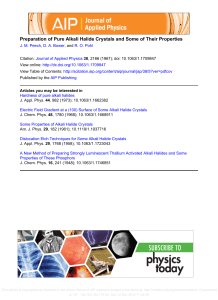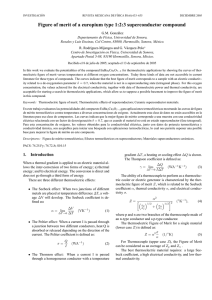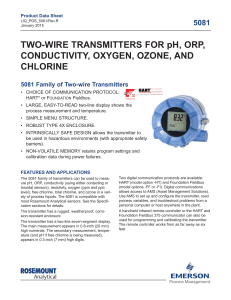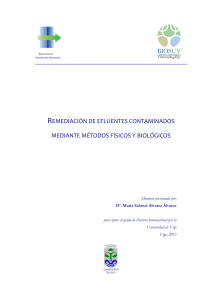LIMIT OF APPLICATION OF THE NON
Anuncio
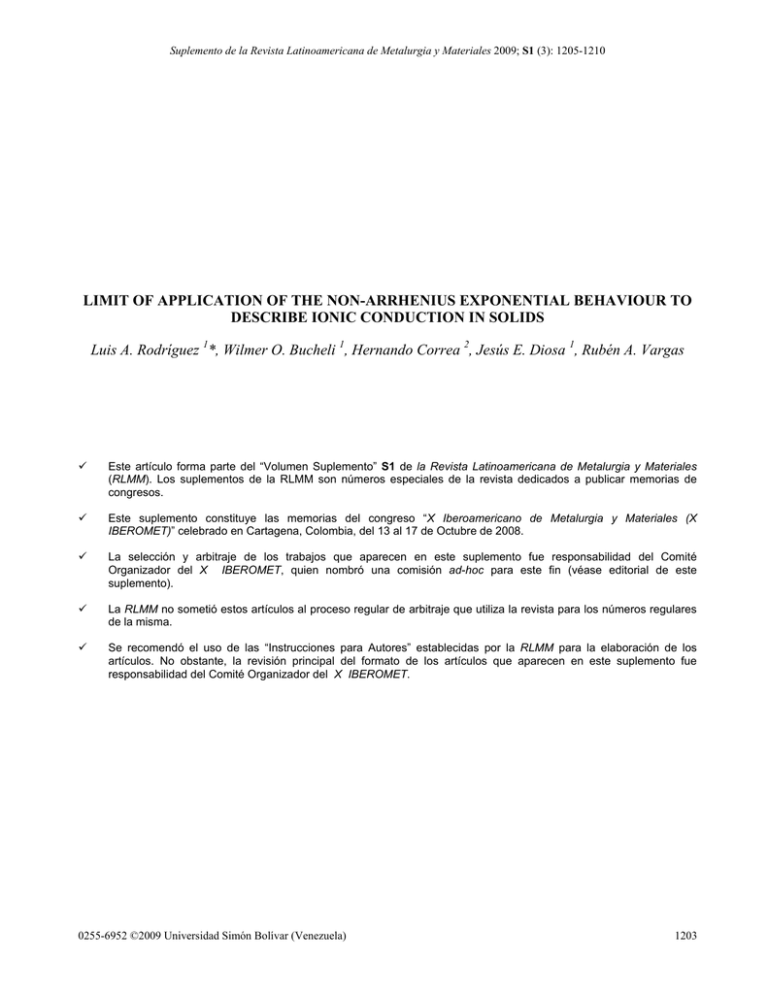
Suplemento de la Revista Latinoamericana de Metalurgia y Materiales 2009; S1 (3): 1205-1210 LIMIT OF APPLICATION OF THE NON-ARRHENIUS EXPONENTIAL BEHAVIOUR TO DESCRIBE IONIC CONDUCTION IN SOLIDS Luis A. Rodríguez 1*, Wilmer O. Bucheli 1, Hernando Correa 2, Jesús E. Diosa 1, Rubén A. Vargas 9 Este artículo forma parte del “Volumen Suplemento” S1 de la Revista Latinoamericana de Metalurgia y Materiales (RLMM). Los suplementos de la RLMM son números especiales de la revista dedicados a publicar memorias de congresos. 9 Este suplemento constituye las memorias del congreso “X Iberoamericano de Metalurgia y Materiales (X IBEROMET)” celebrado en Cartagena, Colombia, del 13 al 17 de Octubre de 2008. 9 La selección y arbitraje de los trabajos que aparecen en este suplemento fue responsabilidad del Comité Organizador del X IBEROMET, quien nombró una comisión ad-hoc para este fin (véase editorial de este suplemento). 9 La RLMM no sometió estos artículos al proceso regular de arbitraje que utiliza la revista para los números regulares de la misma. 9 Se recomendó el uso de las “Instrucciones para Autores” establecidas por la RLMM para la elaboración de los artículos. No obstante, la revisión principal del formato de los artículos que aparecen en este suplemento fue responsabilidad del Comité Organizador del X IBEROMET. 0255-6952 ©2009 Universidad Simón Bolívar (Venezuela) 1203 Suplemento de la Revista Latinoamericana de Metalurgia y Materiales 2009; S1 (3): 1205-1210 LIMIT OF APPLICATION OF THE NON-ARRHENIUS EXPONENTIAL BEHAVIOUR TO DESCRIBE IONIC CONDUCTION IN SOLIDS Luis A. Rodríguez 1*, Wilmer O. Bucheli 1, Hernando Correa 2, Jesús E. Diosa 1, Rubén A. Vargas 1: Departamento de Física, Universidad del Valle. A.A. 25360, Cali, Colombia 2: Laboratorio de Optoelectrónica. Universidad del Quindío. Armenia, Colombia * E-mail: [email protected] Trabajos presentados en el X CONGRESO IBEROAMERICANO DE METALURGIA Y MATERIALES IBEROMET Cartagena de Indias (Colombia), 13 al 17 de Octubre de 2008 Selección de trabajos a cargo de los organizadores del evento Publicado On-Line el 29-Jul-2009 Disponible en: www.polimeros.labb.usb.ve/RLMM/home.html Resumen En este trabajo reportamos un modelo fenomenológico para comportamientos no Arrhenius de la dependencia con la temperatura de la conductividad iónica (expresada en una escala logarítmica, log(σ)) en electrolitos sólidos, basado en una función algebraica fraccionaria del inverso de la temperatura (T-1). En particular, el modelo describe bien tanto aquellos sistemas que exhiben un decaimiento exponencial en el comportamiento de log(σ) en términos de 1000/T, como aquellos que tienen una tendencia a un comportamiento de Arrhenius, esto es, ellos están en el límite entre el comportamiento de Arrhenius y el comportamiento exponencial decreciente cuando se grafica log(σ) versus 1000/T. El modelo da cuenta de la variación con la temperatura de la energía de activación por los diferentes efectos de relajación en el transporte iónico en estado sólido. Palabras Claves: Conductividad iónica, comportamiento de Arrhenius y no-Arrhenius Abstract In this work we report a phenomenological model for non-Arrhenius behavior of the temperature dependence of the ionic conductivity (expressed in a logarithmic scale, log(σ)) in solids electrolytes, based on a fractional algebraic function of the inverse temperature (T-1). In particularly, the model describes well either those systems that exhibit an exponential decrease behavior of log(σ) versus 1000/T, or those that have a tendency to the Arrhenius behavior, that is, they are in the limit between the Arrhenius and the decrease exponential behavior of log(σ) in terms of 1000/T. The model accounts the observed variation with temperature of the activation energy due to different effects of electrical relaxations in solid state ionics. Keywords: Ionic conductivity, Arrhenius and non-Arrhenius behavior 1. INTRODUCTION Different from electronic conduction, ionic conduction in ionic solids is closely related to a particular structural characteristic of crystals known as a substantial sublattice disorder. The large ionic conductivity is due to a mass motion of a large number of diffusing ions in this sublattice and the presence of passageways in its structure for the charge carriers. Thus, the factors that influence the solid state conductivity are the concentration of charge carriers, availability of vacant-accessible sites which is controlled by the density of defects in the crystal and an open crystal structure resulting in passageways for ion migration, from its normal 0255-6952 ©2009 Universidad Simón Bolívar (Venezuela) lattice position to another site. An energy barrier for hopping called the “activation energy” describes the accomplishment of this process. The activation energy is a phenomenological quantity associated to single particle hops. Cooperative motion of the ions is also essential, such that an ion out of equilibrium position moves though the lattice without changing its configurational entropy. This explanation of the experimental activation energy from dcconductivity measurements requires that the “particle” hopping has a low energy barrier [1]. A general expression for the ionic conductivity is σ = ∑ ni ⋅ qi ⋅ μ i (1) i 1205 Rodríguez et al. 340 -3.6 -1 -1 log(σ)(cm Ω ) 320 -4.0 -4.4 -4.8 (a) 2.4 2.6 2.8 -1 1000/T (K ) 3.0 3.2 Temperature (K) 400 380 360 340 -3.2 20 Hz 4464 Hz 200000Hz 1000000Hz -3.6 -1 320 -4.0 -4.4 -4.8 -5.2 (b) -5.6 2.4 2.6 2.8 -1 1000/T (K ) 3.0 3.2 Temperature (K) (2) -3.2 400 380 360 340 320 20 Hz 4464 Hz 200000 Hz -3.6 -4.0 -1 -1 LIMIT BETWEEN THE EXPONENTIAL AND THE ARRHENIUS EXPRESSIONS: MOTIVATION The temperature dependence of the ionic conductivity for the three concentration (x = 0.1, 0.2 and 0.3) show very particular behavior (see Fig. 1), quite different from one to another. For x = 0.1 (Fig. (a)), we note that all the data points are described well by the same function, independently of frequency. That is, in the tested frequency range (20Hz - 1MHz), the temperature dependence of the 1206 360 20 Hz 4464 Hz 200000 Hz 420 where k1, k2 y C are fitting parameters [7]. 2. 380 -3.2 log(σ)(cm Ω ) ⎡ ⎛ 1000 ⎞⎤ − k1 ⎟ ⎥ ⎢− ⎜ T ⎠⎥ + C log(σ ) = exp⎢ ⎝ 1 ⎢ ⎥ k2 ⎢ ⎥ ⎣ ⎦ Temperature (K) 400 -1 In an attempt to describe the ionic conductivity, several models have been developed, among which the one based on the random walk approach, it is described by an Arrhenius equation. It determines a linear relationship between log(σ) and the inverse of temperature. The problem is then to generalize the random walk approach to systems which include large cooperative effects. Those conductivity that do not meet this linearity are known as non-Arrhenius behaviors of the ionic conductivity. One of the models proposed to describe non-Arrhenius behaviors in polymer electrolytes is the VTF model (Vogel-Tamman-Fulcher) [3-5]. This is an empirical relationship originally developed to describe the viscosity of supercooled liquids and where the “pseudoenergy” of activation, determined in this model, is associated with the barrier energy that the charge carriers need to overcome to move into the substance [6]. Our research team is currently interested in developing an equation based on exponential terms that adjust non-Arrhenius temperature dependence of the ionic conductivity, observed mainly on AgI-based electrolytes. We have found that systems such as that with composition (1-x)(NaI+4AgI) – x(Al2O3) for x = 0.1, 0.2 and 0.3 show an exponential decrease of log(σ) in terms of 1000/T described by: activation energies, d(logσ)/d(T-1), for all curves at fixed frequency, are identical. However, for x = 0.2 and 0.3 (Figs. 1 (a) and (b)) the fitting functions to log(σ)(cm Ω ) where ni, qi and μi are the concentration, charge and mobility, respectively, of the ith moving species [2]. This equation is however difficult to use since it is often impossible to get an estimate of the number of different carriers charge in the system. -4.4 -4.8 -5.2 (c) -5.6 2.4 2.6 2.8 3.0 3.2 -1 1000/T (K ) Figure 1. Experimental conductivity data in Arrhenius plots and fitting curves using an exponential function for the conductivity as a function of 1000/T (Eq. 2) at different frequencies between 20 Hz and 1MHz of the system (1-x)(NaI+4AgI)-x(Al2O3): (a) x = 0.1, (b) x = 0.2 and (c) x = 0.3. Rev. LatinAm. Metal. Mater. 2009; S1 (3): 1205-1210 Limit of application of the non-arrhenius exponential behaviour to describe ionic the data points are no longer identical, showing a frequency dependence of the conductivity at a given temperature. One way to find the explanation of the observed behavior as a function temperature and frequency is by looking at the electrical response of the moving ions as a function of frequency at constant temperature, and then selecting the identical regimes of ionic transport in the whole spectra. It is important to point out that the measuring cell is a two-electrodes configuration Pt/sample/Pt in which the two main contributions to the impedance of the cell are from the sample’s bulk electrical response that dominate at higher frequencies or lower temperatures and the grain boundaries effects at the sample-electrode interface that dominate at lower frequencies or higher temperatures. By plotting the conductivity data at a frequency where the electrical response obeys the same regime, that is, at a frequency where all the isotherms (when plotted as a function of frequency) exhibit the same variation, then a linear behavior in the Arrhenius plot is observed. However, at certain frequencies, as that shown if Fig. 2, if it is analyzed in detail, a small curvature is apparent, characteristic of an decreasing exponential function. So, at this limiting case, ¿which will be the best fitting function to the conductivity data?. To solve this dilemma, we wish to present here a study of these two functions when they approach to each other as a limiting case of electrical response of the moving-ion subsystem in solid ionic conductors. 3. EXPERIMENTAL METHODS The different samples with composition (1-x)(NaI+4AgI)–x(Al2O3) (x = 0.1, 0.2 and 0.3) were prepared from previously grown polycrystalline samples of NaI-4AgI and nanoparticles of Al2O3 (grain size 565.3 Å) The composites were prepared by thoroughly mixing the component in an agate mortar and then heated for 1 hour at 120oC. The polycrystalline samples of NaI4AgI were grown by solving casting methods. Ultrapure powders of AgI and NaI (Aldrich) with a molar fraction of 4:1 were dissolved in HI (57% aqueous solution) at 48oC under a dry atmosphere. After 3 weeks of solvent evaporation under these conditions, small crystals with the given composition were grown. Acetone was used as solvent to clean the crystals before mixing them with the nanoceramic powder. Rev. LatinAm. Metal Mater. 2009; S1 (3): 1205-1210 The electrical characterization of the samples was done by impedance spectroscopy (IS) [8] using a two electrode configuration Pt/sample/Pt and a home-built temperature and atmosphere controlled cell for measurements. The electrode-electrolyte contact surface (A) and the distance between electrodes (d) were measured using a micrometer. No corrections for thermal expansion of the cell were carried out. The measurements were carried out with a computer controlled LCR meter in the frequency range of 20Hz-1.0 MHz, in the isothermal or in the heating cooling modes at temperatures between 320 ≤ T ≤ 412K under a dry N2 atmosphere. To carry out the impedance measurements cylindrical pellets of 1 mm thickness and 6 mm in diameter were prepared by uniaxial pressure of about 2 tons/cm2. From the impedance data, Z(ω)=Z’(ω)-iZ”(ω) (where ω = 2πf / Hz is the angular frequency, i = (-1)1/2, the real part of the electrical conductivity, σ’(ω) = (d/A)(Z’/(Z’2+Z’’2), was obtained. 4. RESULTS AND DISCUSSION The figure 2 evidence a peculiar behavior: the tendency of the data seem to follow a straight line, but when realized a lineal fit of the data, we see how the tendency of the point decrease, following a curve which can be described with an decrease exponential function, developed by Rodriguez et al. [7]. We can talk that the tendency of these points are in a boundary or limit between the model proposed by Arrhenius and the decrease exponential function. From the Arrhenius equation we can interpret the conductivity as: log(σ ) = − Ea log(e) ⎛ 1000 ⎞ ⎜ ⎟ + log(σ 0 ) 1000k ⎝ T ⎠ (3) where e = 2.71828182…), k is the Boltzmann’s constant and σ0 is the preexponential factor. On the other hand, the conductivity of the system using the decrease exponential function is expressed using equation (2). In the limit between these two functions, the values of log(σ), as shown in Figure 2, are very similar. Thus, in this limit, equating the right-hand sides of equations (2) and (3) and solving for Ea, we obtain ⎧ ⎡ ⎛ 1000 ⎫ ⎞⎤ −⎜ − k1 ⎟ ⎥ ⎪ ⎪ ⎢ − kT ⎪ ⎝ T ⎠⎥ +η⎪ Ea lim ≈ ⎨exp ⎢ ⎬ log(e) ⎪ ⎢ k2 ⎥ ⎪ ⎥ ⎪⎩ ⎢⎣ ⎪⎭ ⎦ (4) 1207 Rodríguez et al. ⎡ ⎛ 1000 ⎞⎤ − k1 ⎟ ⎥ ⎢− ⎜ 1000k T ⎠⎥ Ea exp = exp ⎢ ⎝ k 2 log(e) k2 ⎥ ⎢ ⎥ ⎢ ⎦ ⎣ (5) Figure 3 represents the temperature dependence of the activation energies Ealim and Eaexp. It is noted that Ealim is approximately constant, while Eaexp change linearly with temperature. Since the values of Eaexp were calculated from the fitting of the conductivity data to the exponential function, we might perform a rotation transformation to carry Ealim values to those of Eaexp. This was achieved by a rotation around a point very close to the intersection of the two lines by an angle φ and changing the temperature scale to 1000kT. 0,80 0,75 Ea exponential 0,70 Ea (eV) where η = C1–log(σ0) the calculated activation energy by Ealim. Considering that the activation energy in an Arrhenius plot of the ionic conductivity can be calculated from the slope d(log(σ))/d(T-1) [5] which we identified as Eaexp, using the expression (2), we have 0,65 Ea limit 0,60 0,55 0,50 360 370 380 390 T (K) 400 410 420 Figure 3.Temperature dependence of Ealim (solid line) and Eaexp (dashed line) as calculated from the expressions (4) and (5), respectively. The conductivity data corresponds to sample with concentration x = 0.3 at the frequency of 300000Hz, and in the temperature range between 367 K and 416 K. 0.80 0.75 Ea exponential 23076 Hz 0.70 Ea (eV) -4.6 -1 -1 log(σ)(cm Ω ) -4.4 0.65 Ea limit 0.60 Ea lim 0.55 -4.8 Ea exp 0.50 -5.0 E'a lim 31 32 33 34 35 36 1000kT (eV) 2.8 2.9 3.0 -1 1000/T (K ) 3.1 Figure 2. Logσ versus 1000/T for x = 0.3 at the frequency of 23076 Hz where the ionic conduction obeys the same mechanism in the temperature range between 320 K and 360 K. The dotted line represents the fitting to the Arrhenius equation (3) while the solid line is the fitting to the exponential expression (2). Figure 4. The same as Fig. 3 but scaling the temperature axis to 1000kT and including the rotated Ealim by an angle φ (dashed line). Performing the rotation transformation on Ealim, we obtain: Ea' lim = −1000kT sin(φ ) + Ea lim cos(φ ) + A = −1000kT sin(φ ) + It is important to point out performing the rotation with the energy scale for the T-axis shown in Figure 4, then the angle φ will be related to the slope mexp obtained by linear regression fitting of the points belonging to the plot Eaexp vs. 1000kT function, by φ ≈ π + mexp [7] 1208 ⎡ ⎧ ⎡ ⎛ 1000 ⎫⎤ ⎞⎤ − k1 ⎟ ⎥ ⎢ ⎪ ⎢− ⎜ ⎪⎥ ⎠ ⎥ + η ⎪⎥ cos(φ ) (6) ⎢ − kT ⎪exp ⎢ ⎝ T ⎬⎥ ⎢ log(e) ⎨ ⎢ ⎥ k2 ⎪ ⎪⎥ ⎢ ⎥ ⎢ ⎪ ⎪⎭⎥ ⎦ ⎩ ⎣ ⎣⎢ ⎦ +A Rev. LatinAm. Metal. Mater. 2009; S1 (3): 1205-1210 Limit of application of the non-arrhenius exponential behaviour to describe ionic where E’alim is the rotated function of Ealim and A is a adjusting parameter that account for the best chosen center of rotation. We notice that, for certain values of φ y A, E’alim ≈ Eaexp, then, by equating expressions (5) and (6), and using equation (2), we obtain ⎛ 1000 ⎞ a⎜ ⎟+b T ⎠ ⎝ log(σ ) = 1000 +c T (7) where a = (Ak2log(e))/(1000k) + C1 c = k2⋅cos(φ) (8c) which is a fractional algebraic function of the variable 1000/T 5. APPLICATION FRACTIONAL ALGEBRAIC FUNCTION TO THE CONDUCTIVITY DATA OF THE (1-x)(NaI+4AgI) – x(Al2O3) SYSTEM. Figure 5 shows the Arrhenius plots of the temperature dependence of the conductivity data for the x = 0.2 composite at various frequencies. These frequency values correspond to temperature region (between 320K and 416K ) where the ionic transport obeys the same mechanism. These Arrhenius plots show the limit of application of the two fitting function, i.e., the Arrhenius and exponential ones. Temperature (K) -3.2 380 360 Calculated values Freq. (Hz) a b (K-1) c (K-1) a b (K-1) c (K-1) 862 -8.9 16.9 -1.0 -9.1 17.1 -0.9 1090 -9.0 16.9 -1.0 -9.1 17.1 -0.9 75000 -8.9 15.9 -0.7 -9.0 16.3 -0.7 500000 -7.2 14.2 -1.4 -7.7 14.7 -1.0 320 -4.0 In these cases, our proposed fractional algebraic function (eq. 7) is used to fit that data curves. Table 1 shows the best fitting parameter values (a, b and c). Table 1 also shows the calculated values of these parameters using the expressions (8a), (8b) and (8c) showing wood agreement with those obtained by fitting. Thus, we are presenting a new approach to analyze ionic conductivity data as a function of temperature for those transport processes in which the Arrhenius behavior is not quite evident. 6. CONCLUSIONS On analyzing the ionic conductivity of the highly dispersive ionic conductors as those based on AgI, it is frequently found that when presenting the data as Arrhenius plots, the temperature dependence of d(logσ)/d(T-1) is not constant as a function of temperature. In these case, we previously found a good fitting to the data points by using an exponential-type function [7]. Moreover, we have shown in this work, that when both the Arrhenius and the exponential-type function are in the limit of their applications, then a fractional algebraic function is a good alternative to describe the observed behavior of the conductivity data. -1 -1 log(σ)(cm Ω ) 340 862 Hz 1090 Hz 75000 Hz 500000 Hz -3.6 Fitting values (8a) b = - k2(1000log(e)⋅sin(φ) – log(σ0)⋅cos(φ) (8b) 400 Table 1. Fitting parameters (a, b, c) to the Arrhenius plots for the temperature dependence of the conductivity data for the x=0.2 composite at various frequencies, according to the fractional equation (7). -4.4 -4.8 -5.2 2.4 2.6 2.8 -1 1000/T (K ) 3.0 3.2 Figure 5. Arrhenius plots of the temperature dependence of the conductivity data for the x=0.2 composite at various frequencies. The continuous lines are the fitting curves to rational function (13). Rev. LatinAm. Metal Mater. 2009; S1 (3): 1205-1210 7. ACKNOWLEDGEMENTS This work was financially supported in part by Colciencias (Colombia) under the project No. 0252004, and the Excellent Center for Novel Materials (CENM) 8. REFERENCES [1] Padma Kumar P, Yashonath S. J. Chem. Sci. 2006; 118 (1): 135-154. [2] Agrawal RC, Gupta K. “Superionic solids: composite electrolyte phase – an overview”, 1209 Rodríguez et al. [3] [4] [5] [6] [7] [8] 1210 Journal of Materials Science. 1999; 34: 11311162. Vogel H. Phys.Z. 1921; 22: 645. Tammann G, Hesse W. Z. Anorg. Allg. Chem.1926; 156: 245. Fulcher GS. J. Am. Chem. Soc. 1925; 8: 339. Eliasson H. “Dielectric and Conductivity Studies of a Silver Ion Conducting Polymer”. Göteborg University (Sweden). 1998; 5-14. Rodriguez LA. “Estudio del Efecto del Al2O3 en las Propiedades Eléctricas del Sistema NaI+4AgI”. Universidad del Valle (Colombia). 2007; 41-42. Barsoukov E, Mc Ross Donald J. “Impedance Spectroscopy Theory, Experimental, and Applications”, Second Edition. A Jhon Wiley & Sons, Inc., Publication. 2005; 2-7. Rev. LatinAm. Metal. Mater. 2009; S1 (3): 1205-1210


